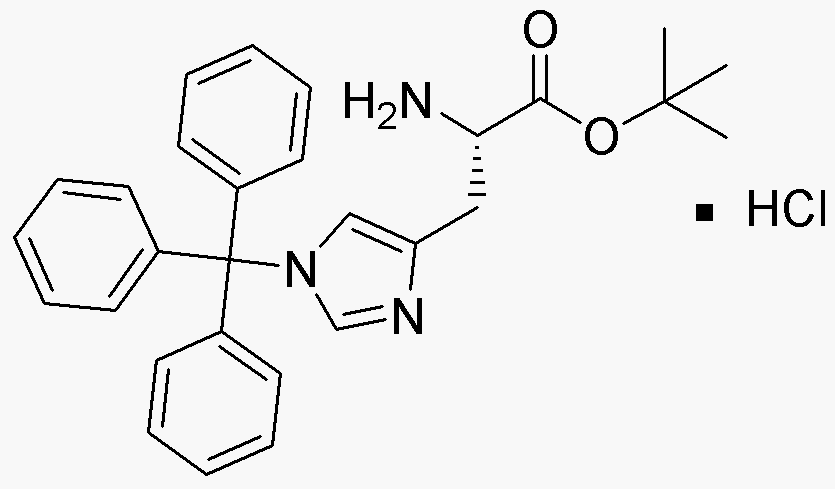Nim-Trityl-L-histidine tert-butyl ester hydrochloride is widely utilized in research focused on:
- Peptide Synthesis: This compound serves as a protective group in the synthesis of peptides, allowing for the selective modification of amino acids without disrupting the overall structure.
- Drug Development: It plays a crucial role in the development of new pharmaceuticals, particularly in the design of histidine-containing compounds that can enhance drug efficacy.
- Biochemical Research: Researchers use it to study protein interactions and enzyme activities, providing insights into biochemical pathways and mechanisms.
- Analytical Chemistry: This compound is used as a standard in various analytical techniques, helping to ensure accuracy and reliability in quantitative analysis.
- Therapeutic Applications: Its derivatives are being explored for potential therapeutic uses, particularly in areas such as cancer treatment and immunotherapy.
General Information
Properties
Safety and Regulations
Applications
Nim-Trityl-L-histidine tert-butyl ester hydrochloride is widely utilized in research focused on:
- Peptide Synthesis: This compound serves as a protective group in the synthesis of peptides, allowing for the selective modification of amino acids without disrupting the overall structure.
- Drug Development: It plays a crucial role in the development of new pharmaceuticals, particularly in the design of histidine-containing compounds that can enhance drug efficacy.
- Biochemical Research: Researchers use it to study protein interactions and enzyme activities, providing insights into biochemical pathways and mechanisms.
- Analytical Chemistry: This compound is used as a standard in various analytical techniques, helping to ensure accuracy and reliability in quantitative analysis.
- Therapeutic Applications: Its derivatives are being explored for potential therapeutic uses, particularly in areas such as cancer treatment and immunotherapy.
Documents
Safety Data Sheets (SDS)
The SDS provides comprehensive safety information on handling, storage, and disposal of the product.
Product Specification (PS)
The PS provides a comprehensive breakdown of the product’s properties, including chemical composition, physical state, purity, and storage requirements. It also details acceptable quality ranges and the product's intended applications.
Certificates of Analysis (COA)
Search for Certificates of Analysis (COA) by entering the products Lot Number. Lot and Batch Numbers can be found on a product’s label following the words ‘Lot’ or ‘Batch’.
Numéro de catalogue
Numéro de lot/série
Certificates Of Origin (COO)
This COO confirms the country where the product was manufactured, and also details the materials and components used in it and whether it is derived from natural, synthetic, or other specific sources. This certificate may be required for customs, trade, and regulatory compliance.
Numéro de catalogue
Numéro de lot/série
Safety Data Sheets (SDS)
The SDS provides comprehensive safety information on handling, storage, and disposal of the product.
DownloadProduct Specification (PS)
The PS provides a comprehensive breakdown of the product’s properties, including chemical composition, physical state, purity, and storage requirements. It also details acceptable quality ranges and the product's intended applications.
DownloadCertificates of Analysis (COA)
Search for Certificates of Analysis (COA) by entering the products Lot Number. Lot and Batch Numbers can be found on a product’s label following the words ‘Lot’ or ‘Batch’.
Numéro de catalogue
Numéro de lot/série
Certificates Of Origin (COO)
This COO confirms the country where the product was manufactured, and also details the materials and components used in it and whether it is derived from natural, synthetic, or other specific sources. This certificate may be required for customs, trade, and regulatory compliance.


